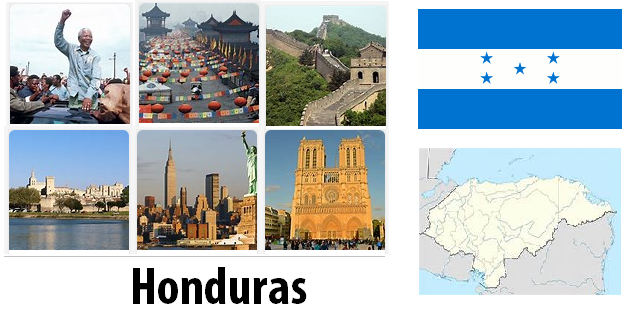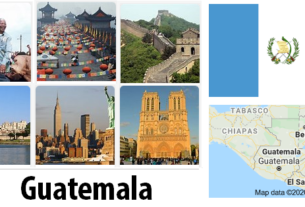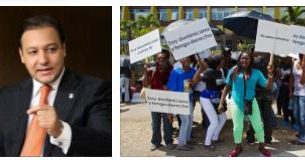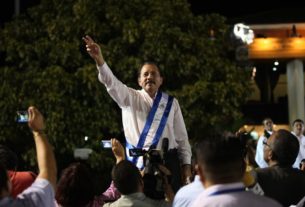The first explorations of this area were started by the Maya from the second century of the Christian era; this is attested by the grandiose ruins and the famous Copan stele. At the end of the sixth century and the beginning of the seventh, the Mayans left the region to move to Yucatan.
In their place came the Aztecs, by means of peaceful commercial expeditions.
Discovered in 1502 by Christopher Columbus, it was occupied entirely by Spain in 1523 (but until 1823 it was part of the General Captaincy of Guatemala). The king of Spain in 1530 ordered that all the conquered territories depended on the Audiencia of Mexico; this caused disagreements and conflicts that lasted for a long time.
In May 1544 an Audiencia de los Confines was founded which was to unify the countries of Central America, excluding Yucatan. In 1821 Mexico decreed its independence and did the same for Honduras, freeing itself from Spanish domination, moving towards independence through the Confederation of the Republics of Central America, which lasted from 1823 to 1839.
On 11 December 1825 it was established that the capital of Honduras should be the largest and most populous city of the moment, that is Comayagua; this however shortly after was destroyed by fire and then the capital became Tegucigalpa.
The presidency of the Confederation from 1830 to 1835 was in the hands of a Honduran of exceptional intelligence and character D. Francesco Morazan. But then it dissolved in 1839 because the five states that were part of it wanted, each for its own account, to erect independent states. Honduras proclaimed itself independent in 1840 although, for some time, it made attempts to restore the Confederacy. Vain were the numerous interventions also by the presidents of the other states of Central America. However, alliance treaties and commercial and legal agreements were concluded, such as the resolution of Corinth (in Nicaragua) with the agreement by Costa Rica, Nicaragua,
Honduras then had military struggles with Guatemala in 1906; with Nicaragua and Salvador in 1907. In 1921 I confederate with Guatemala and Salvador, but the alliance failed. And, however, in 1922 an attempt was still made, in the Washington conference, chaired by Secretary of State Hugues, to reconstitute the Federation of Central America, but none of the nations concerned ratified the 14 articles of the treaty and the matter closed.
In September 1924, a Constitution was issued under the dictatorship of Gutierrez; there were later civil wars and other dictatorships and in November 1932, under the presidency of Tiburcio Carias Andino, a revolt led by the liberal Drangel Huete occurred, extinguished a month later.
In 1936, the reconfirmed President Carias, promulgated a new Constitution, always with an authoritarian orientation.
In 1937 the State Monopoly was established for the sale of spirits, alcohol, salt and weapons.
The economic situation, hitherto precarious due to the destruction of the banana plantations affected by the “Panama Hurt”, slightly improved in 1940 because the experimental cultivation of the rubber plant had extended.
In the same period, to favor “continental politics”, he burdened Japanese goods with very strong duties, until they entered the country; then broke diplomatic ties with the Tripartite, after expelling the German business appointee. Immediately after the attack on Pearl Harbor he declared war on Japan, Germany and Italy.
After that, due to the decreased export of bananas to the United States, work to build the great “pan-American road” with iron bridges intensified to overcome unemployment, the last of which was completed in 1944. It was built also the road from Tegucigalpa to the Pacific and the United Fruit Company introduced the cultivation of hemp.
In July 1944, still president T. Carias Andino, a revolution broke out; he proclaimed the state of siege; he bombed Ocotepeque; but he managed to stay in power because he conceded wage increases at the same time.
In 1945, continuing the uprising, he freed political prisoners and in 1946 scaled down the demonstrations of the Democratic Action party. Carias celebrated his 13th year of presidency.
Meanwhile diplomatic relations were resumed with both China and the USSR; the United Nations pact was approved and a trade pact was entered into with Canada, with the particular clause that made Canada the favored partner.
New crops were introduced: that of abacà (special banana trees whose fibers were used to weave Manilla’s hemp), barbasco (medicinal plant), rice and soy. All this because the foodstuffs were rather scarce.
After the Second World War, the export of bananas resumed, but in October 1945 a very strong hurricane brought destruction and death and there were damages of about 15 million dollars.
After the long dictatorship of Carias Andino, in 1948 Juan Manuel Galvez came to the government who immediately started the indispensable social reforms to get the country out of illiteracy and from the general primitive working conditions in which the population was. See Countryaah for population and country facts about Honduras.
Despite his wise conduct, in April 1954 the workers employed by the Union Fruit Company proclaimed a general strike, at the conclusion of which they obtained the possibility of founding the unions. A month later, Honduras signed a military assistance treaty with the United States; a month later a large and well-equipped army left from Honduras, commanded by Castillo Armas, who overthrew the government of Guatemala.




